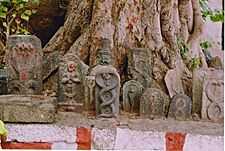Tuluva dynasty
| Vijayanagara Empire | |||||||||||||||||||||||||||||||||||||||||||||||||||||||||||||||||||
|---|---|---|---|---|---|---|---|---|---|---|---|---|---|---|---|---|---|---|---|---|---|---|---|---|---|---|---|---|---|---|---|---|---|---|---|---|---|---|---|---|---|---|---|---|---|---|---|---|---|---|---|---|---|---|---|---|---|---|---|---|---|---|---|---|---|---|---|
| |||||||||||||||||||||||||||||||||||||||||||||||||||||||||||||||||||
Tuluva was the third dynasty of the Vijayanagara Empire.
History

The Tuluva were the third Hindu dynasty which ruled Vijayanagara empire. The dynasty was founded by chieftain Bunts who originally ruled southern parts of coastal Karnataka, also called Tulu Nadu. Some people believe that the dynasty might have gained the name "Tuluva" because they belonged to the Tulu speaking region of Tulu Nadu and their mother tongue was the ancient Tulu language . Narasa Nayaka, the father of Krishnadevaraya is the governor of Chandragiri in Andhra and Krishnadevaraya wrote in his popular work Amuktamalyada that he is Telugu (telugu vallabhunda) and it is a Telugu country (desambu telugu). They came to power after the Saluva Dynasty.
The Tuluva dynasty were the most powerful dynasty of the Vijayanagara Empire of Southern India. They belonged to the Nagavanshi kshatriya order of lineage. They are believed to be Nagavanshis who worshiped Nagaraja Vasuki (name for a naga, one of the serpents of mythology) as their family deity. The Vijayanagar empire attained it greatest glory during this period and their most famous emperor Krishna Deva Raya. Their reign consisted of five emperors from 1491 till 1570. They ruled almost the entire South India with Vijayanagara as their capital. The fall of the Tuluva dynasty led the beginning of the disintegration of the empire.
This period was known as a golden age of Telugu literature. Many Telugu, Sanskrit, Kannada and Tamil poets enjoyed the patronage of the emperor.
Emperor Krishna Deva Raya earned the titles Andhra Bhoja, Mooru Rayara Ganda (lit, "King of three Kings") and Kannada Rajya Rama Ramana (lit, "Lord of the Kannada empire").
Krishna Deva Raya was formally initiated into the Vaishnava Sampradaya by Vyasatirtha.[17] He patronised poets and scholars in Kannada, Telugu, Tamil and Sanskrit. Sri Vyasatirtha was his Kula-Guru.
Emperor Krishna Deva Raya was fluent in many languages. There remains a debate whether he was a Telugu, Kannadiga [2] or Tuluva by lineage.[3]
Rulers
The five Tuluva emperors were:
- Tuluva Narasa Nayaka
- Viranarasimha Raya
- Krishnadevaraya
- Achyuta Deva Raya
- Sadashiva Raya
See also
- Bunts
- Nagavanshi
- Tulu Nadu
- Tuluva
- Tulu